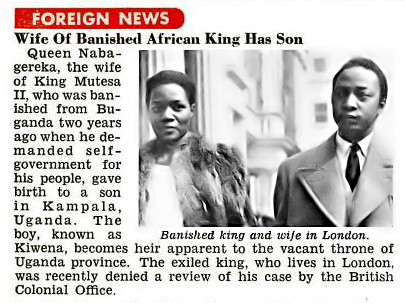The life and times of Kabaka Mutesa II, whose full name was Sir Edward Frederick William David Walugembe Mutebi Luwangula Mutesa, were interesting.
He was the thirty-sixth kabaka (king) of Buganda from 1939 until his death on November 21, 1969. He was also the first President of Uganda from 1963 to 1966, till he was deposed and forced into exile by the Prime Minister, Milton Obote.
He became the King of Buganda in 1939 following the death of his father, King Daudi Cwa II.

He was deposed twice; first by the colonial governor-general Sir Andrew Cohen in 1953, with an eye to installing his half-brother whom he reckoned he could better control, and again in 1966 when he was forced by Prime Minister Obote to flee to Britain, where he died in exile.
After two years of his first exile, Mutesa II was allowed to return to the throne under a negotiated settlement which made him a constitutional monarch and gave the Baganda the right to elect representatives to the kingdom’s parliament, the Lukiiko.
He married 13 wives and had eleven sons and six daughters in wedlock and beyond, including Ronald Frederick Muwenda Mutebi, Dorothy Namukabya Nassolo, Anne Sarah Kagere, Suna, Ndawula, Catherine Nabaloga, Mukarukidi, Masamba, and Goloba.

On November 9, 1948, Mutesa II married Abakyala Damali Catherine Nnakawombe, Omubitokati Beatrice Kabasweka, of Toro and Kate Ndagire in 1950.
In 1954, he married Abakyala Sarah Nalule. His fifth marriage was to Nesta M. Rugumayo; his sixth to Kaakako Rwanchwende, a princess of Ankole, followed by Winifred Keihangwe, also a princess of Ankole. He appointed Prince Ronald Mutebi as his successor, whose mother was Sarah Nalule.
Sir Edward Mutesa II, KBE and Prime Minister Milton Obote first formed an alliance to demand self-rule, eventually winning power in the 1962 election. Mutesa II was appointed non-executive president, largely playing a ceremonial role but after independence, the cordiality between the two men started deteriorating.
In 1966, Obote sent soldiers allegedly led by Idi Amin to ransack his stronghold. Mutesa II had to flee once again to the UK.
With him away, Obote appointed himself president, assuming absolute power.

As king, Mutesa II was the leader of the Baganda people, the largest of the many ethnic groups in Uganda. Despite using it to their advantage, Obote, after gaining power, set out to dismantle both the traditional kingships and the autonomy of provincial governments as Buganda had only joined the state on condition that it enjoyed a large degree of autonomy.
In 1993, under a new constitution, Mutesa’s son became the thirty-seventh kabaka. Buganda is now a constitutional monarchy within Uganda.

Mutesa II was educated at King’s College, Budo in Uganda. He attended Magdalene College, Cambridge in England where he joined an officer training corps and was commissioned as a captain in the Grenadier Guards.
At that time, Buganda was part of the British protectorate of Uganda. The British in Uganda ruled through many of the traditional chiefs or kings. The line of kings of Buganda can be traced back to the late fourteenth century.
Curiously, Obote was overthrown in a coup by none other than his own army chief and trusted ally, Amin, in 1971.

Mutesa II died of alcohol poisoning in his London flat in 1969 at the age of 45. His death was identified by the British police as suicide, although his supporters held he was assassinated by agents of the Obote regime.
“We got warning, people used to write and say somebody has been sent, be aware, take care,” one family friend, another Ugandan exile living in London, told the BBC in 2009, four decades after Mutesa II’s death.
According to JM Kavuma-Kaggwa, an elder from Kyaggwe, Mukono District: “There were rumours that Obote was spending Shs 250,000 per week (a lot of money then) to track down the Kabaka. Their mission had completely failed until luck struck when the late Oscar Kambona of Tanzania who fell out with President Nyerere and fled into exile in London, organised a birthday party in November 1969 in Sir Edward Mutesa’s honour.
“Also in attendance was a beautiful Muganda girl who had reportedly been recruited by the GSU to go to London, befriend Sir Edward, be close to him and poison him. She came close to the Kabaka during the party. It was reported that the Kabaka invited the girl to this birthday party and that was the time she managed to poison him because she was the one in charge of the Kabaka’s drinks that evening.”
The body of Mutesa II was returned to Uganda in 1971 after the overthrow of Obote and given a state funeral by the new President Idi Amin, who, as Army Commander, had led the assault on Mutesa’s palace in 1966.

Mutesa II had the honour of serving as his nation’s first president, serving as a symbol of culture and head of a well-established polity. He had adjusted to a constitutional monarchy following his 1955 return from exile and did nothing to undermine it.
The monarchy was restored in 1993, together with the other three traditional kingdoms.










